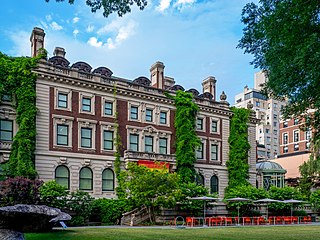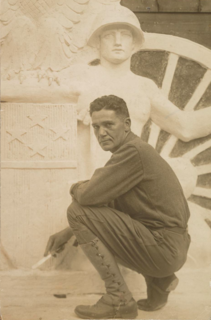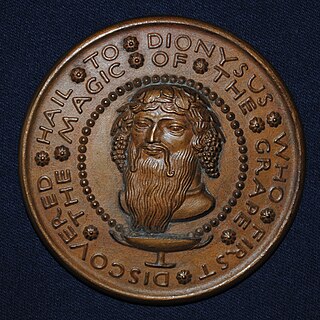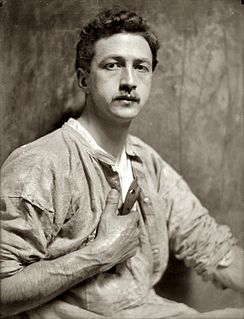The Fidelity Medallion is the oldest decoration of the United States military and was created by act of the Continental Congress in 1780. Also known as the "André Capture Medal", the Fidelity Medallion was awarded to those soldiers who participated in the capture of Major John André, of the British Army, who had been the contact to Benedict Arnold and had helped organize his defection.

Cooper Hewitt, Smithsonian Design Museum is a design museum located in the Upper East Side's Museum Mile in Manhattan, New York City. It is one of 19 museums that fall under the wing of the Smithsonian Institution and is one of three Smithsonian facilities located in New York City, the other two being the George Gustav Heye Center in Bowling Green and the Archives of American Art New York Research Center in the Flatiron District. It is the only museum in the United States devoted to historical and contemporary design. Its collections and exhibitions explore approximately 240 years of design aesthetic and creativity.

The American Numismatic Society (ANS) is a New York City-based organization dedicated to the study of coins and medals. Founded in 1858, it is the only American museum devoted exclusively to their preservation and study. Its collection encompasses nearly one million items, including medals and paper money, as well as the world's most comprehensive library of numismatic literature.

Robert Ingersoll Aitken was an American sculptor. Perhaps his most famous work is the West Pediment of the United States Supreme Court building.

Joseph Farran Zerbe was the President of the American Numismatic Association from 1908 to 1910. In 1969, he was posthumously inducted into the ANA Hall of Fame. An award is named in his honour and awarded by the ANA on an annual basis. His contributions to numismatics include the founding of the Pacific Coast Numismatic Society in San Francisco in 1915.

The Society of Medalists was established in 1930 in the United States to encourage the medallic work of superior sculptors, and to make their creations available to the public. The Society of Medalists was the longest running art medal collector's organization in the United States and released 129 regular issues on a twice yearly basis from 1930 to 1995, as well as special issues marking the Society's 20th, 40th, and 50th anniversaries and the United States Bicentennial in 1976. Much of the inspiration for the Society came from the earlier Circle of Friends of the Medallion, which also issued medals on a semi-annual basis from 1908 to 1915. All issues of the Society were struck by the Medallic Art Company, originally located in New York City
Circle of Friends of the Medallion was formed by Charles DeKay, Robert Hewitt, Jr., and the French-American trio of Jules Edouard Roiné with brothers Felix and Henri Weil, all living in New York City. De Kay, "a newspaperman and art lover" provided the contacts to form the Circle of Friends of the Medallion, often referred to as the Circle of Friends, while Hewitt, "a Manhattan real estate investor" provided the funds for its development. Jules Edouard Roiné and Felix Weil ran the Roiné, Weil and Company (1908-1916) which they collaborated with Henri. Upon Roiné's passing in 1916, Felix and Henri Weil operated the Medallic Art Company of New York. The three men, via both companies, made the 1st, 2nd and 12th medals in the series. Joseph K. Davison & Sons of Philadelphia struck the other medals.

Medallic Art Company, Ltd. based in Dayton, Nevada is "America’s oldest and largest private mint" and specializes in making academic awards, maces, medallions, along with chains of office and universities medals for schools.
Alex Shagin is a coin designer.

Eugene Daub is an American contemporary figure sculptor, best known for his portraits and figurative monument sculpture created in the classic heroic style. His sculptures reside in three of the nation's state capitals and in the National Statuary Hall in the United States Capitol. His work appears in public monuments and permanent collections in the United States and Europe.
Donald Nelson Everhart II is an American coin and medal engraver-medalist, and sculptor who has worked for the private Franklin Mint, as a freelance designer, and since 2004 has worked for the United States Mint in Philadelphia. With over 1,000 models for coins and medals attributed to him as of 2008, he is still at the prime of his career creating the bas-relief models for these and similar sculptural objects. His coin designs are in the pockets of American citizens, and despite his late arrival to the series of the popular U.S. Statehood Quarters, he has designed and modeled three State's unique reverse designs, modeled three others, and six U.S. commemorative coins. His portrait of President William Clinton was chosen for Clinton's second term Inaugural Medal. Among his other medal creations are six Congressional Gold Medals for the U.S. Mint, seven Society of Medalists issues, twelve calendar medals, and other models for private medal makers, as well as cast art medals.

Chester A. Beach was an American sculptor who was known for his busts and medallic art.

Brenda Putnam was a noted American sculptor, teacher and author.

The National Numismatic Collection is the national coin cabinet of the United States. The collection is part of the Smithsonian Institution's National Museum of American History.

Thomas Gaetano LoMedico was an American sculptor and medalist. Born and raised in New York City, his sculpture won awards in the 1930s and 1940s and is now in several American museum collections.
Jules Édouard Roiné, was an exemplary French-American sculptor and master medal engraver of his era.
Agnes Baldwin Brett was an American numismatist and archaeologist who worked as the Curator at the American Numismatic Society from 1910 to 1913. She was the first curator at the American Numismatic Society. She made important contributions to the study of ancient coinage, medals, and sculpture, whose work was used by later archaeologists. Brett was also a visiting lecturer of archaeology at Columbia University in 1936.
A numismatist is a specialist in numismatics. Numismatists include collectors, specialist dealers and scholars who use coins in object-based research. Although the term numismatics was first coined in English in 1829, people had been collecting and studying coins long before this, all over the world.

Maurice Frankenhuis was a Jewish Dutch businessman, historian, researcher, author, collector, numismatist, Holocaust survivor, and philanthropist. He documented the history of World War I and World War II through his family's experiences in the Netherlands and subsequent internment in two concentration camps. Throughout the ordeal he built a collection of memorabilia and authored a firsthand account to the Holocaust of Dutch Jewry. He dedicated himself to educating about the Holocaust, and preserve a record of history for future generations including donations of his collections of medals and posters to various museums around the world, and writing his personal memoirs, observations and commentary on world affairs after the war.